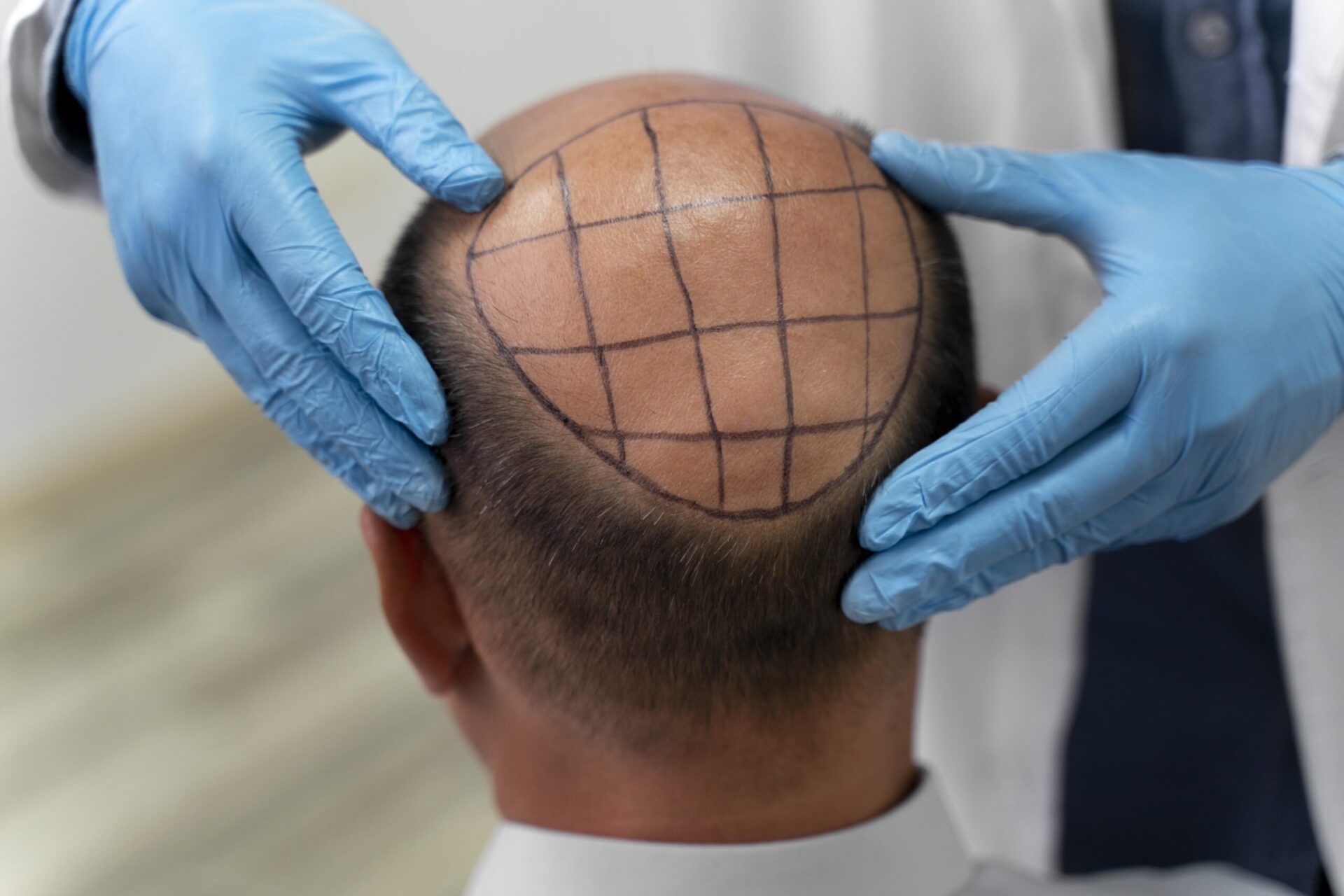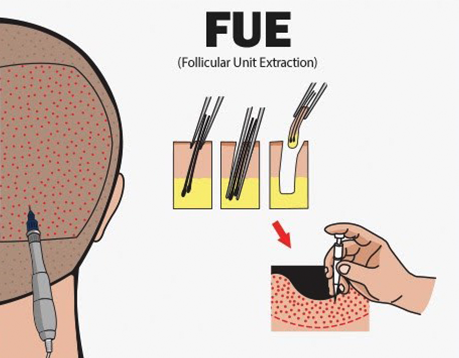FUE hair transplant is a procedure that helps individuals experiencing hair loss regain healthier and fuller hair than before. Hair loss affects individuals both physically and emotionally. Looking youthful and having thick, healthy hair plays a significant role in one’s image.
Among the various hair transplant techniques, FUE is a frequently performed and popular method, helping individuals restore their lost image. FUE hair transplant is quick to perform and offers an easy recovery process. With the FUE technique, individuals can achieve the dense, thick, and healthy hair they’ve always dreamed of in a time-efficient, easy, and permanent manner.
What is FUE Hair Transplant?
FUE hair transplant is one of the most popular methods used for individuals experiencing hair loss and partial baldness. Hair loss can occur due to factors such as aging, stress, genetics, or medication use. This issue, which often affects the front part of the scalp, can negatively impact an individual’s physical appearance. Those who suffer from hair loss may appear older or less groomed and often resort to cosmetic products or accessories like hats or bandanas to conceal the problem. However, these solutions are temporary, and for permanent and natural results, hair transplantation is preferred.

FUE Hair Transplant Method
The FUE hair transplant method involves transplanting hair follicles (grafts) from the donor area to the areas affected by hair loss. As a minimally invasive procedure, it is easy for patients to undergo and offers a quick recovery period. FUE hair transplant delivers highly satisfying results, providing individuals with natural-looking hair and resolving their hair loss concerns. This method enables people to regain thick, healthy hair, creating both aesthetic and psychological benefits.
How is FUE Hair Transplant Performed?
When a patient requests hair transplantation, they are first examined to determine if the FUE technique is suitable for them. The donor area is typically the nape of the neck. In the FUE technique, both the donor area and the recipient area must be shaved. After shaving these areas, an anesthetic cream is applied to numb the transplant zones. Hair follicles are then individually extracted from the donor area and transplanted into the channels opened in the recipient area. Since no tissue is removed in the FUE method, there are no incisions or stitches. The procedure progresses quickly, with an average of 3,000-4,500 hair follicles transplanted in a single session. After the procedure, the patient can immediately return to their daily activities.
FUE Hair Transplant Costs
The cost of FUE hair transplant is not fixed and varies depending on several factors. These include the technique used, the size of the treatment area, the number of sessions, the quality of materials, and the experience of the doctor. After a consultation at our medical center, it can be determined whether FUE hair transplant is suitable for you, and a personalized cost estimate can be provided.
Who is Suitable for FUE Hair Transplant?
FUE hair transplant is an ideal treatment method for individuals experiencing significant hair loss and seeking to regain thick, natural hair. However, certain criteria must be met for the procedure to be successfully performed. The conditions for individuals suitable for FUE hair transplant include:
Individuals who meet these conditions may be suitable candidates for FUE hair transplant and can achieve natural and permanent hair through this method.
What to Consider After FUE Hair Transplant
To ensure the best and most effective results after FUE hair transplant, it is important to follow the doctor’s recommendations and perform the necessary aftercare. Side effects like wounds or scabbing in the donor and transplant areas will typically disappear within 7-10 days. After hair transplantation, the following precautions should be taken:
- Protect the transplanted area from impacts and contact.
- Avoid washing the transplanted area and protect it from weather conditions (sun, rain, etc.).
- Avoid lying on the transplanted area.
- Do not scratch, rub, or pick at the scabs in the treated area.
- Do not comb the transplanted area, and avoid using accessories like hairpins or hats, as well as using hairdryers or applying cosmetic products.
- Refrain from using nicotine-containing substances, such as cigarettes.
- Avoid strenuous activities.
- Stay away from swimming pools, the sea, Turkish baths, and saunas.
The first hair wash is performed 3 days after the FUE procedure by hair transplant specialists at the clinic.
Is FUE Hair Transplant Permanent?
FUE hair transplant provides permanent and long-lasting results. Achieving healthy and quality hair depends on strictly following the post-procedure instructions and ensuring proper aftercare.
What Are the Advantages of FUE Hair Transplant?
The advantages of FUE hair transplant include:
- There is no further hair loss in the transplanted area. The individual permanently regains healthy hair.
- No incisions or stitches are required, making for an easier recovery.
- A large number of hair follicles can be transplanted in a single session, requiring fewer sessions compared to other methods.
- The time between sessions is short.
- There is no pain or discomfort during or after the procedure.
- No scars are left in the donor or recipient areas.
- The individual appears physically younger, boosting their confidence and morale, which positively impacts social and professional relationships.
- The newly grown hair has a natural appearance.
What Should Be Done Before FUE Hair Transplant?
To minimize risks and achieve the desired results, certain steps should be taken before the FUE hair transplant:
- The donor and transplant areas must be sterile.
- Blood-thinning medications should be discontinued 7 days prior to the procedure.
- Hair should be clean, with no cosmetic products (e.g., gel, spray) used.
- Patients should not arrive on an empty stomach and should be well-nourished.
- Comfortable clothing should be worn.
- Any medications being taken should be discussed and approved by the doctor.
Is FUE Hair Transplant Painful?
Before the FUE procedure, local anesthesia is applied to the treatment areas. The patient does not feel any pain during or after the procedure. Once the local anesthesia wears off, there is typically no need for pain relief medication.
Is FUE Hair Transplant Risky?

FUE hair transplant is a risk-free and successful procedure when performed by skilled and experienced professionals. Hair transplantation is an investment of time, money, and effort for individuals, making the quality and effectiveness of the results extremely important. To ensure that the hair transplant is both safe and provides satisfying outcomes, it must be carried out by experienced plastic surgeons in institutions such as medical centers, hospitals, or clinics approved by the Ministry of Health.
Which is Better: FUE or DHI?
The advantages of hair transplant methods vary from one to another. Since every individual’s hair structure, genetic traits, and metabolism are different, the most suitable method for each person can vary. The best technique for a patient can be determined through a doctor’s examination. Here are the key differences between FUE and DHI hair transplant techniques:
- DHI Technique: Hair follicles are extracted one by one from the donor area using a special pen and are immediately transplanted into the tiny incisions made in the recipient area. In the FUE Technique, single, double, or triple hair follicles are extracted and then collectively transplanted into the channels opened in the recipient area.
- DHI Technique: Since it is performed more slowly, around 1,500-2,500 grafts are transplanted per session. In contrast, FUE is faster, allowing for around 3,000-4,500 grafts to be transplanted in each session.
- FUE delivers better results in larger areas, while DHI is more effective in smaller areas.
- The DHI Technique offers a quicker and more comfortable recovery process, whereas recovery with FUE takes longer compared to DHI.
- In the DHI Technique, shaving the hair is not necessary, making it easy to apply to short hair. However, in FUE, shaving the hair is required.
- Since FUE allows for more grafts to be transplanted in a single session, the number of sessions is shorter. The procedure is typically completed in 6-8 hours. With the DHI Technique, the number of sessions and the total transplant time are longer.
Both methods have their own advantages, and the choice between FUE and DHI should be based on the individual’s specific needs and the doctor’s recommendations.
![dr.leyla-arvas-800×1000.jpg[1] dr.leyla arvas](https://www.quartz.com.tr/wp-content/uploads/2024/11/dr.leyla-arvas-800x1000.jpg1_.webp)
Author : Op. Dr Leyla ARVAS
Dr Leyla Arvas is an internationally recognised specialist in aesthetic surgery based in Istanbul. Graduated in 1998 from Istanbul University Faculty of Medicine, she has developed her expertise by studying in Taiwan, Japan and Spain during her 20 years of experience.
This article November 16, 2025 was updated on
Editor: admin@quartz.com.tr


